2018 MERCEDES-BENZ SLC air condition
[x] Cancel search: air conditionPage 31 of 298

The vehicle is read out by employees of the ser-
vice network (including the manufacturer) using
special diagnostic testers. More detailed infor-
mation is obtained from it, if required.
After am alfunction has been rectified, the infor-
mation is deleted from the malfunction memory
or is continually overwritten.
When operating the vehicle, situations are con-
ceivable in which this technical data, in connec-
tion with other information (if necessary, under
consultation with an authorized expert), could
be traced to ap erson.
Examples include: R
accident reports R
damage to the vehicle R
witness statements
Further additional functions that have been con-
tractually agreed upon with the customer allow
certain vehicle data to be conveyed by the vehi-
cle as well. The additional functions include, for
example, vehicle location in case of an emer-
gency.
COMAND/mbrace (Canada: TELEAID) If the vehicle is equipped with COMAND or
mbrace, additional data about the vehicle's
operation, the use of the vehicle in certain sit-
uations, and the location of the vehicle may be
compiled through COMAND or the mbrace sys-
tem.
For additional information please refer to the
COMAND User Manual or the Digital Operator's
Manual and/or the mbrace Terms and Condi-
tions.
Event dat ar ecordersThis vehicle is equipped with an event data
recorder (EDR). This vehicle is equipped with an
event data recorder (EDR). The main purpose of
an ED Ristor ecord, in certain crash or near
crash-lik es ituations, such as an air bag deploy-
ment or hittin gar oad obstacle, data that will
assist in understanding how av ehicle's systems
performed. The ED Risd esigned to record data
related to vehicle dynamics and safety systems
for as hort period of time, typically 30 seconds
or less. The ED Rint his vehicle is designed to record
such data as: R
How various systems in your vehicle were
operating R
Whether or not the driver and passenger
safety belts were buckled/fastened R
How far (if at all) the driver was depressing the
accelerator and/or brake pedal and R
How fast the vehicle was traveling.
These data can help provide ab etter under-
standin goft he circumstances in which acci-
dents and injuries occur. NOTE: ED Rd ata are
recorded by your vehicle only if an on-trivial
crash situation occurs; no data is recorded by
the ED Ru nder normal driving conditions and no
personal data (e.g. name, gender, age and acci-
dent location) are recorded. However, other par-
ties, such as law enforcement could combine
ED Rd ata with the type of personally identifying
data routinely acquired during ac rash investi-
gation.
Access to the vehicle and/or the ED Risn eeded
to read data that is recorded by the EDR, and
special equipment is required. In addition to the
vehicle manufacturer, other parties that have
the special equipment, such as law enforce-
ment ,c an read the information by accessing the
vehicle or the EDR.
ED Rd ata may be used in civil and criminal mat-
ters as at ool in accident reconstruction, acci-
dent claims and vehicle safety. Sinc et he Crash
Data Retrieval CDR tool that is used to extract
data from the ED Risc ommercially available,
Mercedes-Benz USA ,L LC ("MBUSA") expressly
disclaims any and all liability arising from the
extraction of this information by unauthorized
Mercedes-Benz personnel.
MBUSA will not share ED Rd ata with others
without the consen toft he vehicle owners or, if
t he vehicle is leased, without the consen toft he
lessee. Exceptions to this representation
include responses to subpoenas by law enforce-
ment ;byf ederal, state or local government; in
connection with or arising out of litigation involv-
ing MBUSA or its subsidiaries and affiliates; or,
as required by law.
Warning: The ED Risac omponent of the
Restraint System Module. Tampering with, alter-
ing, modifying or removing the ED Rc omponent
may result in am alfunction of the Restraint Sys-
tem Module and other systems.
Stat el aws or regulations regarding EDRs that
conflict with federal regulation are pre-empted.Data stored in the vehicle 29
Introduction Z
Page 47 of 298
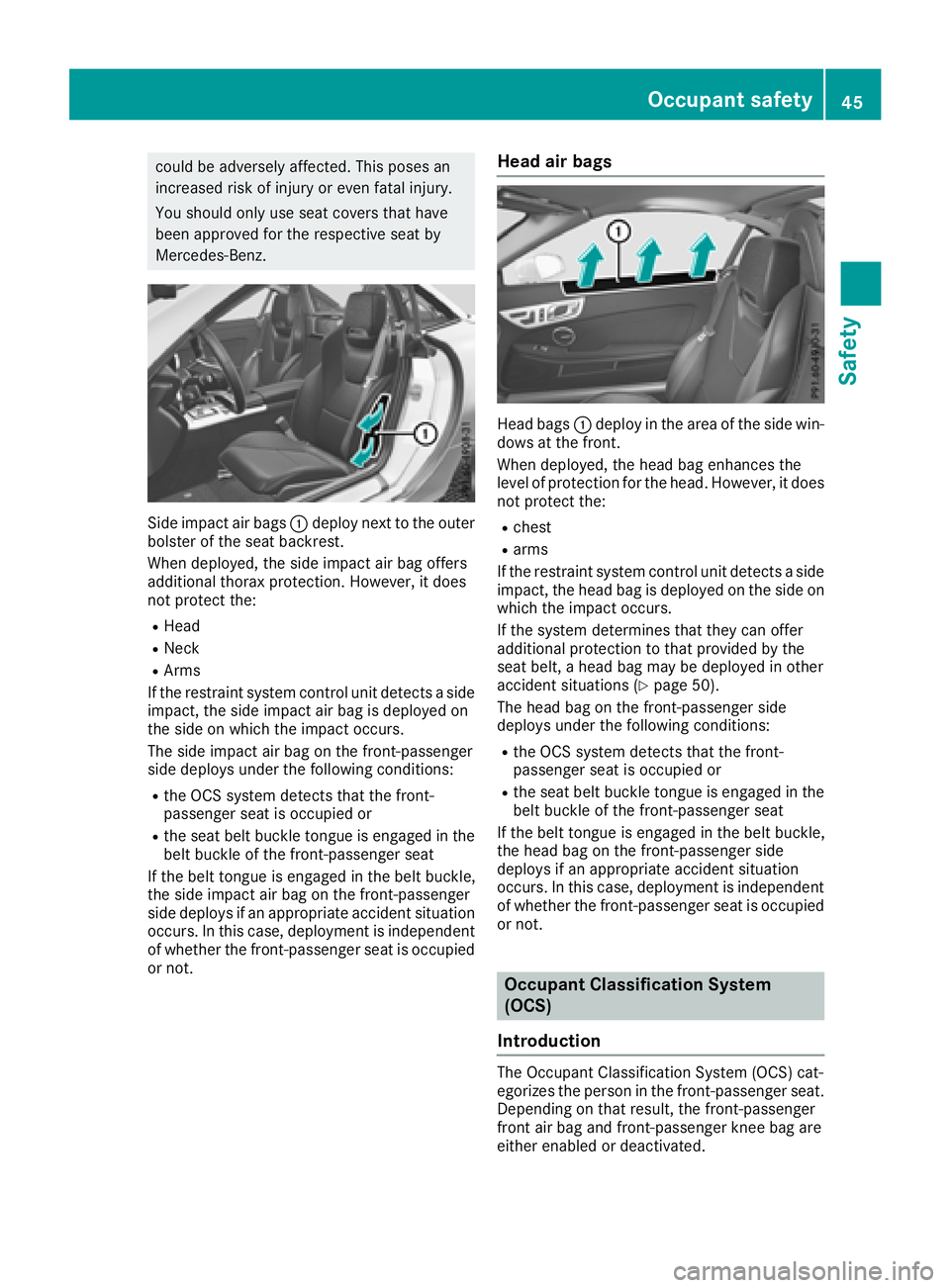
could be adversel ya ffected. Thi sp oses an
increase dr is kofi njury or eve nf ata li njury.
You shoul do nly us es ea tc over st hat have
bee na pp roved for the respectiv es ea tb y
Mercedes-Benz.
Sid ei mpact ai rb ag s �C deploy next to the outer
bolster of the sea tb ac krest.
Whe nd eployed, the sid ei mpact ai rb ag offers
additiona lt hora xp rotection. However, it does
not protect the: R
Head R
Neck R
Arms
If the restraint system control uni td etects as ide
impact, the sid ei mpact ai rb ag is deployed on
the sid eonw hich the impact occurs.
The sid ei mpact ai rb ag on the front-passenger
sid ed eploy su nder the following conditions:R
the OCS system detects that the front-
passenger sea ti so ccupied orR
the sea tb el tb uc kle tongu eise ngaged in the
bel tb uc kle of the front-passenger seat
If the bel tt ongu eise ngaged in the bel tb uc kle,
the sid ei mpact ai rb ag on the front-passenger
sid ed eploy sifana pp ropriate accident situation
occurs. In this case ,d eployment is independent
of whether the front-passenger sea ti so ccupied
or not. Head air bags
Hea db ag s �C deploy in the are aoft he sid ew in -
dow satt he front.
Whe nd eployed, the hea db ag enhances the
level of protectio nf or the head. However, it does
not protect the: R
chest R
arms
If the restraint system control uni td etects as ide
impact, the hea db ag is deployed on the sid eo n
which the impact occurs.
If the system determine st hat they can offer
additiona lp rotectio ntot hat provided by the
sea tb elt, ah ea db ag may be deployed in other
accident situations ( Y
page 50).
The hea db ag on the front-passenger side
deploy su nder the following conditions: R
the OCS system detects that the front-
passenger sea ti so ccupied orR
the sea tb el tb uc kle tongu eise ngaged in the
bel tb uc kle of the front-passenger seat
If the bel tt ongu eise ngaged in the bel tb uc kle,
the hea db ag on the front-passenger side
deploy sifana pp ropriate accident situation
occurs. In this case ,d eployment is independent
of whether the front-passenger sea ti so ccupied
or not.
Occupan tC la ssificatio nS ystem
(OCS)
Introduction
The Occupant Classification System (OCS) cat-
egorize st he person in the front-passenger seat.
Depending on that result, the front-passenger
front ai rb ag and front-passenger knee ba ga re
either enabled or deactivated.Occupan ts afety 45
Safety Z
Page 48 of 298

The system does not deactivate: R
the side impact air bag R
the headbag R
the Emergency Tensionin gD evices
Requirements To be classified correctly, the front passenger
must sit: R
with the seat belt fastened correctly R
in an almost upright position with their back
against the seat backrest R
with their feet restin gont he floor, if possible
If the front passenger does not observe these
conditions, OCS may produce af alse classifica-
tion, e.g. because the front passenger: R
transfers their weight by supporting them-
selves on av ehicle armrestR
sits in such aw ay that their weight is raised
from the seat cushion
If you install ac hild restraint system on the
front-passenger seat, be sure to observe the
correc tp ositionin goft he child restraint system.
Never place object su nder or behind the child
restraint system, e.g. ac ushion. The entir eb ase
of the child restraint system must alway sr est on
the seat cushion of the front-passenger seat.
The backrest of the forward-facing child
restraint system must lie as flat as possible
against the backrest of the front-passenger
seat.
The child restraint system must not touch the
roof or be subjected to al oad by the head
restraint. Adjust the angle of the seat backrest
and the head restraint position accordingly.
Only then can OCS be guaranteed to function
correctly. Always observe the child restraint sys-
tem manufacturer's installation and operating
instructions. Occupant Classification System opera-
tion (OCS)
�C
PASSENGER AIR BAG ON indicator lamp �D
PASSENGER AIR BAG OFF indicator lamp
The indicator lamps inform you whether the
front-passenger front air bag is deactivated or
enabled. X
Press the Start/Stop button once or twice, or
turn the SmartKey to position �G or �H in the
ignition lock.
The system carries out self-diagnostics.
The PASSENGER AIR BAG OFF and PASSENGER
AIR BAG ON indicator lamps must light up simul-
taneously for approximately six seconds.
The indicator lamps display the status of the
front-passenger front air bag. R
PASSENGER AIR BAG ON lights up for 60 sec-
onds, subsequently both indicator lamps are
off (PASSENGER AIR BAG ON and OFF): the
front-passenger front air bag is able to deploy
in the event of an accident. R
PASSENGER AIR BAG OFF lights up: the front-
passenger front air bag is deactivated. It will
then not be deployed in the event of an acci-
dent.
If the PASSENGER AIR BAG ON indicator lamp is
off, only the PASSENGER AIR BAG OFF indicator
lamp shows the status of the front-passenger
front air bag. The PASSENGER AIR BAG OFF
indicator lamp may be lit continuously or be off.
If the status of the front-passenger front air bag
changes while the vehicle is in motion ,ana ir bag
display message appears in the instrument clus-
ter ( Y
page 187). When the front-passenger
seat is occupied, alway sp ay attention to the
PASSENGER AIR BAG OFF indicator lamp. Be
aware of the status of the front-passenger front
air bag both before and during the journey.46
Occupant safety
Safety
Page 49 of 298
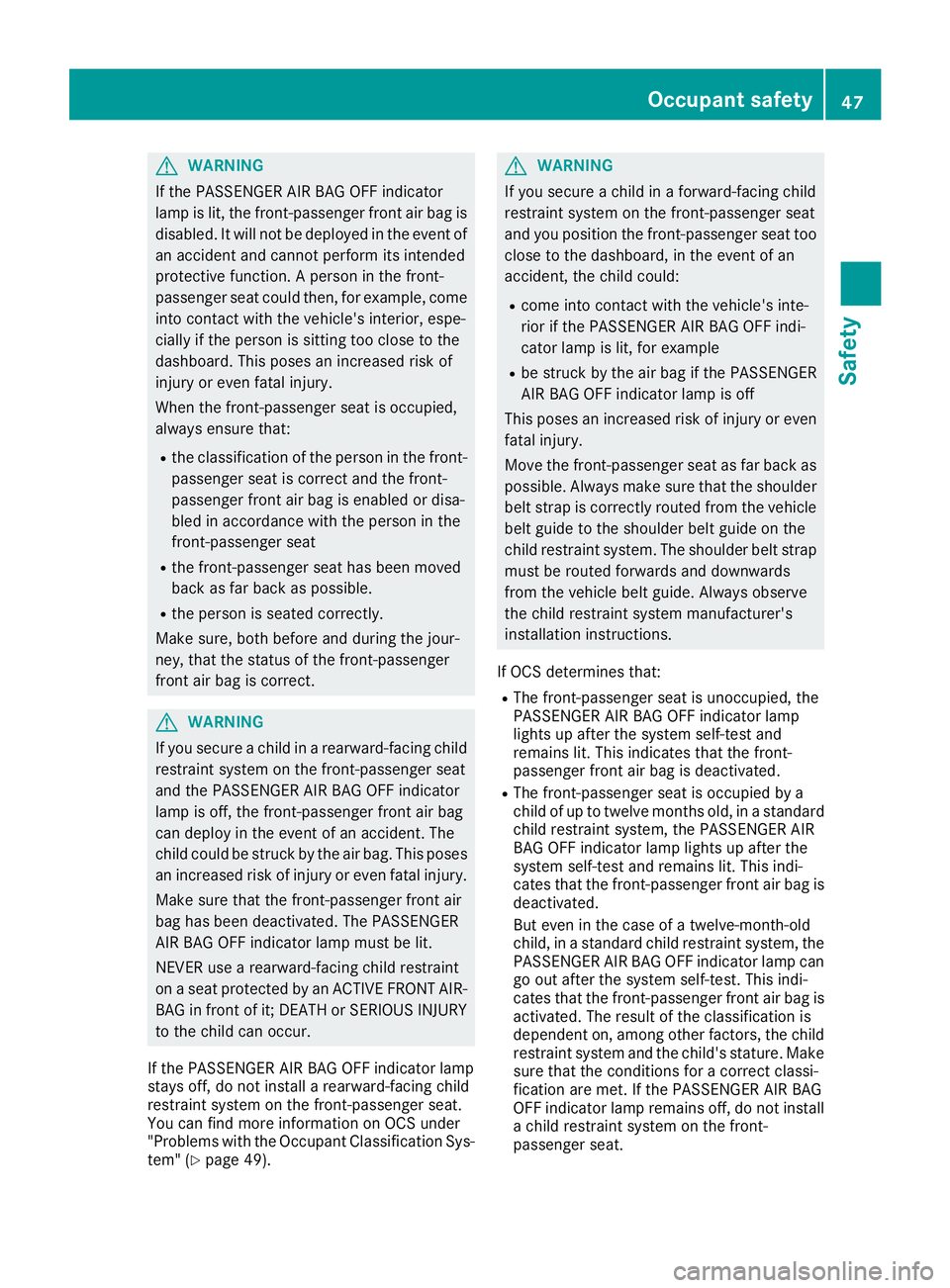
G WARNING
If the PASSENGER AIR BAG OFF indicator
lamp is lit, the front-passenge rf ront air bag is
disabled. It wil ln ot be deploye dint he event of
an accident and cannot perform its intended
protective function. Ap erso nint he front-
passenger seat coul dt hen, for example, come
into contact with the vehicle's interior, espe-
cially if the perso niss itting too close to the
dashboard. This pose sani ncreased risk of
injury or even fatal injury.
When the front-passenge rs eat is occupied,
alway se nsure that:R
the classification of the perso nint he front-
passenger seat is correct and the front-
passenger front air bag is enabled or disa-
ble dina ccordance with the perso nint he
front-passenge rs eatR
the front-passenge rs eat has been moved
back as far back as possible. R
the perso niss eated correctly.
Make sure ,b oth before and during the jour-
ney, that the status of the front-passenger
front air bag is correct.
G WARNING
If you secure ac hild in ar earward-facing child
restraint system on the front-passenge rs eat
and the PASSENGER AIR BAG OFF indicator
lamp is off, the front-passenge rf ront air bag
can deploy in the event of an accident. The
child coul dbes truck by the air bag .T his poses
an increased risk of injury or even fatal injury.
Make sure that the front-passenge rf ront air
bag has been deactivated. The PASSENGER
AIR BAG OFF indicator lamp must be lit.
NEVER use ar earward-facing child restraint
on as eat protected by an ACTIVE FRONT AIR-
BAG in front of it; DEATH or SERIOUS INJURY
to the child can occur.
If the PASSENGER AIR BAG OFF indicator lamp
stays off, do not instal lar earward-facing child
restraint system on the front-passenge rs eat.
You can find more information on OCS under
"Problems with the Occupant Classification Sys-
tem" ( Y
pag e4 9). G WARNING
If you secure ac hild in af orward-facing child
restraint system on the front-passenge rs eat
and you position the front-passenge rs eat too
close to the dashboard, in the event of an
accident, the child could: R
come into contact with the vehicle's inte-
rior if the PASSENGER AIR BAG OFF indi-
cator lamp is lit, for example R
be struck by the air bag if the PASSENGER
AIR BAG OFF indicator lamp is off
This poses an increased risk of injury or even
fatal injury.
Move the front-passenge rs eat as far back as
possible .A lways make sure that the shoulder
bel ts trap is correctly routed from the vehicle
bel tg uide to the shoulde rb el tg uide on the
child restraint system. The shoulde rb el ts trap
must be routed forwards and downwards
from the vehicl eb el tg uide. Always observe
the child restraint system manufacturer's
installation instructions.
If OCS determines that: R
The front-passenge rs eat is unoccupied ,t he
PASSENGER AIR BAG OFF indicator lamp
lights up after the system self-test and
remains lit. This indicates that the front-
passenger front air bag is deactivated. R
The front-passenge rs eat is occupied by a
child of up to twelve months old, in as tandard
child restraint system, the PASSENGER AIR
BAG OFF indicator lamp lights up after the
system self-test and remains lit. This indi-
cates that the front-passenge rf ront air bag is
deactivated.
But even in the case of at welve-month-old
child ,inas tandard child restraint system, the
PASSENGER AIR BAG OFF indicator lamp can
go out after the system self-test. This indi-
cates that the front-passenge rf ront air bag is
activated. The result of the classification is
dependent on, among other factors, the child
restraint system and the child's stature. Make
sure that the conditions for ac orrect classi-
ficatio na re met. If the PASSENGER AIR BAG
OFF indicator lamp remains off, do not install
ac hild restraint system on the front-
pa ss
enger seat.Occupant safety 47
Safety Z
Page 52 of 298

Problem
Possible causes/consequences and �P Solutions
The PASSENGER AIR
BAG OFF indicator lamp
lights up and remains lit,
even though the front-
passenger seat is occu-
pied by an adult or ap er-
son of as tature corre-
sponding to that of an
adult. The classification of the person on the front-passenger seat is incor-
rect. X
Make sure the condition sf or ac orrect classification of the person
on the front-passenger seat are met ( Y
page 46).X
If the PASSENGER AIR BAG OFF indicator lamp remains lit, the front-
passenger seat may not be used. X
Have OCS checked as soon as possible at an authorized Mercedes-
Benz Center.
The PASSENGER AIR
BAG OFF indicator lamp
does not light up and/or
does not stay on.
The front-passenger seat
is: R
unoccupied R
occupied by the
weight of ac hild up to
twelve months old in a
child restraint system OCS is malfunctioning. X
Make sure there is nothin gb etween the seat cushion and the child
seat. X
Make sure that the entire base of the child restraint system rests on
the seat cushion of the front-passenger seat. The backrest of the
forward-facing child restraint system must lie as flat as possible
against the backrest of the front-passenger seat. If necessary,
adjust the position of the front-passenger seat. X
When installing the child restraint system, make sure that the seat
belt is tight. Do not pull the seat belt tight using the front-passenger
seat adjustment .T his could result in the seat belt and the child
restraint system being pulled too tightly. X
Check for correct installation of the child restraint system.
Make sure that the head restraint does not apply al oad to the child
restraint system. If necessary, adjust the head restraint accord-
ingly. X
Make sure that no object sa re applying additional weight onto the
seat. X
If the PASSENGER AIR BAG OFF indicator lamp remains off and/or
the PASSENGER AIR BAG ON indicator lamp lights up, do not install
ac hild restraint system on the front-passenger seat. X
Have OCS checked as soon as possible at an authorized Mercedes-
Benz Center.
Deployment of Emergency Tensioning
Devices and air bags
Important safety notes
G WARNING
The air bag parts are hot after an air bag has
been deployed. There is ar isk of injury.
Do not touch the air bag parts. Have a
deploye da ir bag replaced at aq ualified spe-
cialist workshop as soon as possible. G WARNING
Ad eploye da ir bag no longer offers any pro-
tection and cannot provide the intended pro-
tection in an accident. There is an increased
risk of injury.
Have the vehicle towed to aq ualified special-
ist workshop in order to have ad eploye da ir
bag replaced.
For your own safety and that of your front
passenger, it is important that you have
deploye da ir bags replaced and faulty air bags
repaired. This will help to make sure the air bags50
Occupant safety
Safety
Page 54 of 298
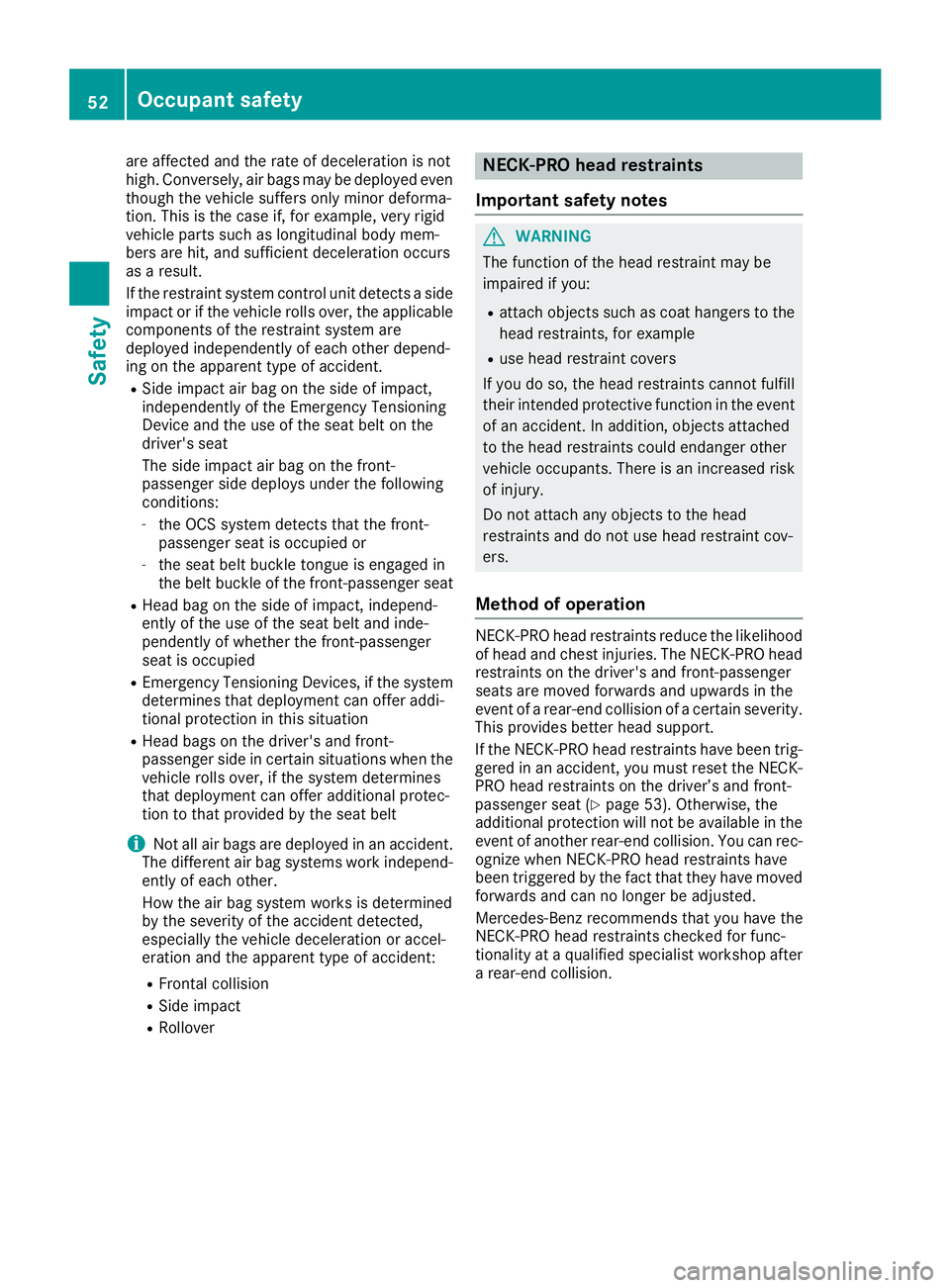
are affected and th er at eofd eceleratio nisn ot
high .C onversely, air bags may be deployed even
though th ev ehicle suffers only minor deforma-
tion. This is th ec as ei f, for example, ver yr igid
vehicle part ss uc hasl ongitudinal body mem-
bers are hit ,a nd sufficient deceleratio no ccurs
as ar esult.
If th er estraint system control unit detect sas ide
impac torift he vehicle roll so ver, th ea pplicable
component soft he restraint system are
deployed independently of each other depend-
ing on th ea pparent type of accident.R
Sid ei mpac ta ir bag on th es ide of impact,
independently of th eE me rgenc yT ensioning
Devic ea nd th eu se of th es eat belt on the
driver' ss eat
The side impac ta ir bag on th ef ront -
passenger side deploys unde rt he following
conditions: -
th eO CS system detect st ha tt he front-
passenger seat is occupied or -
th es eat belt buckle tongue is engaged in
th eb elt buckle of th ef ront-pa ssenger seatR
Head bag on th es ide of impact, independ-
ently of th eu se of th es eat belt and inde-
pendently of whether th ef ront-pa ssenger
seat is occupied R
Emergenc yT ensioning Devices, if th es ystem
determine st ha td eploymen tc an offer addi-
tional protection in this situation R
Head bags on th ed river' sa nd front-
passenger side in certain situations when the
vehicle roll so ve r, if t h es ystem
determines
that deploymen tc an offer additional protec-
tio ntot ha tp rovided by th es eat belt
i Not all air bags are deployed in an accident.
The differen ta ir bag systems work independ-
ently of each other.
How th ea ir bag system work sisd etermined
by th es everit yoft he acciden td etected,
especially th ev ehicle deceleratio nora ccel-
eration and th ea pparent type of accident:R
Frontal collision R
Sid ei mpactR
Rollover NECK-PR Oh ea dr estraints
Important safety notes
G WARNING
The function of th eh ead restraint may be
impaired if you: R
attach object ss uc hasc oat hanger stot he
head restraints, for example R
use head restraint covers
If you do so, th eh ead restraint sc anno tf ulfill
their intended protective function in th ee vent
of an accident. In addition ,o bject sa ttached
to th eh ead restraint sc oul de ndanger other
vehicle occupants. Ther eisani ncreased risk
of injury.
Do no ta ttach any object stot he head
restraint sa nd do no tu se head restraint cov-
ers.
Method of operation NECK-PRO head restraint sr educ et he likelihood
of head and chest injuries .T he NECK-PRO head
restraint sont he driver' sa nd front-passenger
seat sa re moved forwards and upwards in the
even tofar ear-en dc ollision of ac ertain severity.
This provides bette rh ead support.
If th eN EC K-PRO head restraint sh ave been trig-
gered in an accident, you must reset th eN EC K-
PRO head restraint sont he driver’s and front-
passenger seat ( Y
page 53) .O th erwise, the
additional protection will no tbea vailabl eint he
even tofa nother rear-en dc ollision .Y ou can rec-
ognize when NECK-PRO head restraint sh ave
been triggered by th ef ac tt ha tt he yh ave moved
forwards and can no longer be adjusted.
Mercedes-Ben zr ecommend st ha ty ou have the
NECK-PRO head restraint sc he cked for func-
tionalit yataq ualified specialist workshop after
ar ear-en dc ollision.52
Occupant safety
Safety
Page 82 of 298
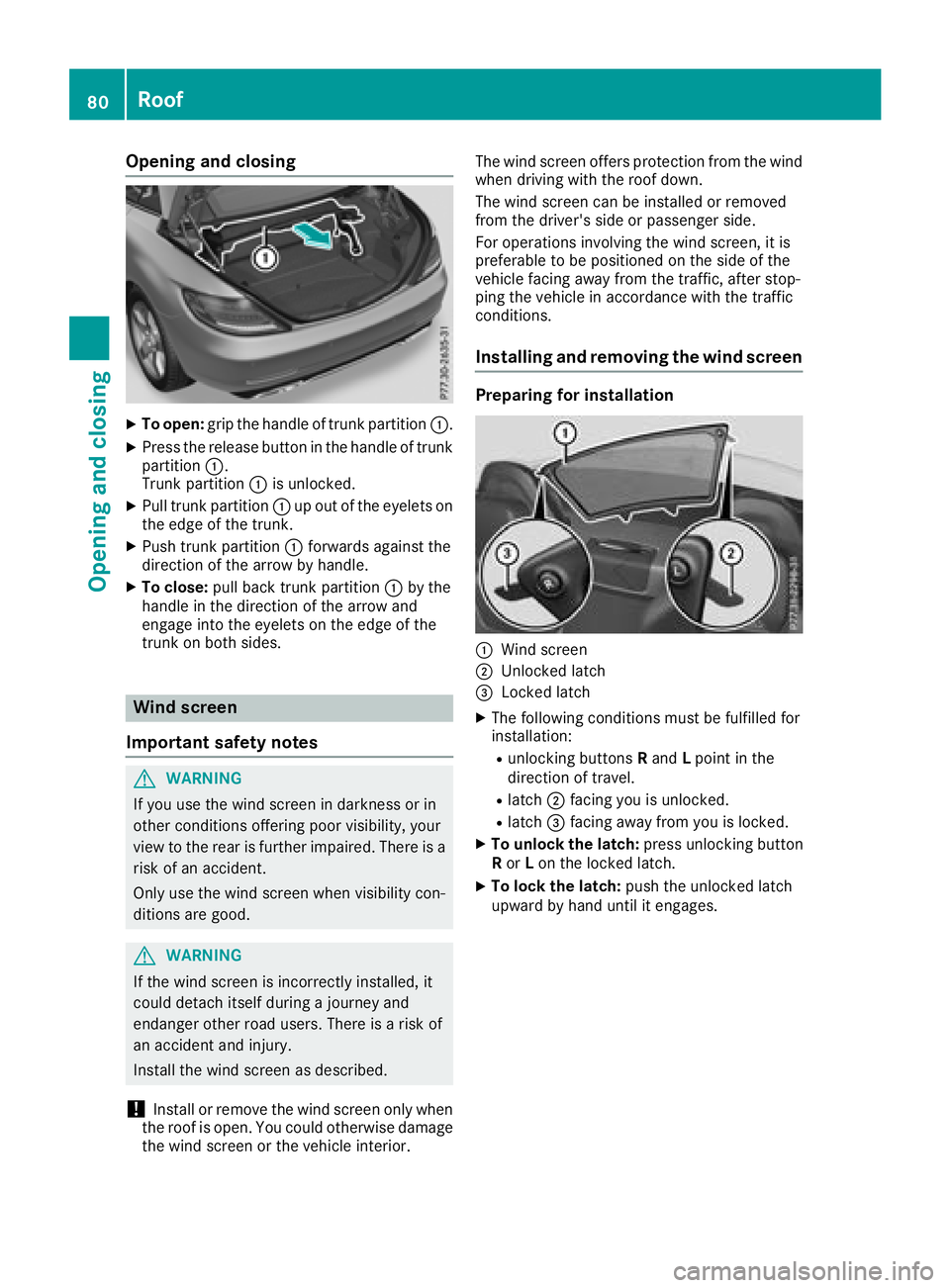
Opening and closing X
To open: grip the handle of trun kp artition �C .X
Press the release button in the handle of trunk
partition �C .
Trunk partition �C is unlocked.X
Pull trun kp artition �C up out of the eyelets on
the edge of the trunk. X
Push trun kp artition �C forwards against the
direction of the arrow by handle. X
To close: pull back trun kp artition �C by the
handle in the direction of the arrow and
engage into the eyelets on the edge of the
trun konb oth sides.
Wind screen
Important safet yn otes
G WARNING
If you use the wind screen in darkness or in
other conditions offerin gp oor visibility, your
view to the rear is further impaired. There is a
risk of an accident.
Only use the wind screen when visibility con-
ditions are good.
G WARNING
If the wind screen is incorrectly installed, it
could detach itself during aj ourney and
endanger other road users. There is ar isk of
an acciden ta nd injury.
Install the wind screen as described.
! Install or remove the wind screen only when
the roof is open. You could otherwise damage
the wind screen or the vehicle interior. The wind screen offers protection from the wind
when driving with the roof down.
The wind screen can be installed or removed
from the driver's side or passenger side.
For operation si nvolvin gt he wind screen ,iti s
preferable to be positioned on the side of the
vehicle facing away from the traffic, after stop-
ping the vehicle in accordance with the traffic
conditions.
Installing and removing the wind screen Preparing for installation
�C
Wind screen �D
Unlocked latch �
Page 106 of 298
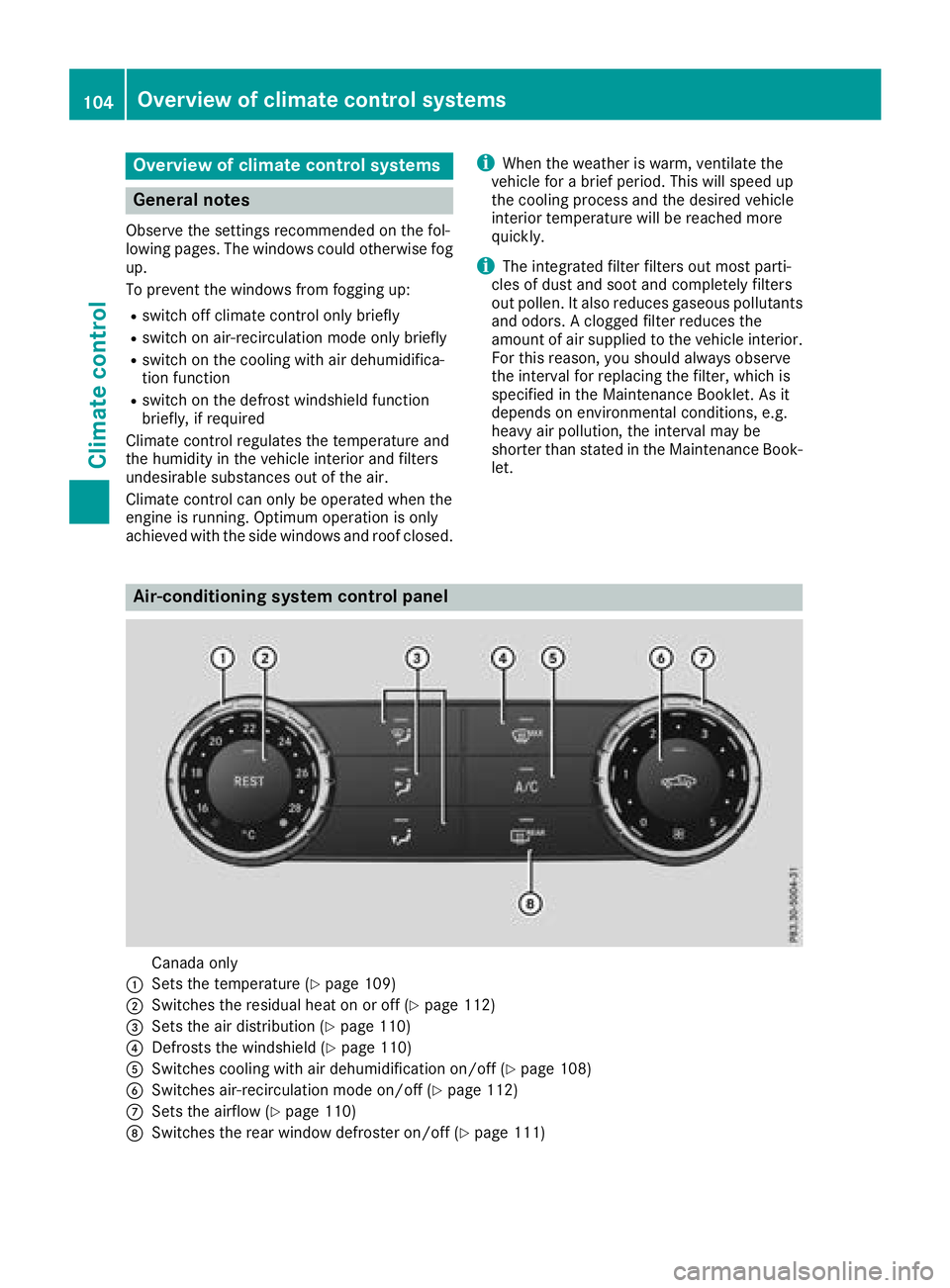
Overview of climat ec ontrol systems
General notes Observe the settings recommended on the fol-
lowing pages. The windows could otherwise fog
up.
To preven tt he windows from fogging up:R
switch off climate control only briefly R
switch on air-recirculation mode only briefly R
switch on the cooling with air dehumidifica-
tion function R
switch on the defrost windshield function
briefly, if required
Climate control regulates the temperature and
the humidity in the vehicle interior and filters
undesirable substances out of the air.
Climate control can only be operated when the
engin eisr unning. Optimum operation is only
achieved with the side windows and roof closed. i When the weather is warm, ventilate the
vehicle for ab rief period. This will speed up
the cooling process and the desired vehicle
interior temperature will be reached more
quickly.
i The integrated filter filters out most parti-
cles of dust and soot and completely filters
out pollen. It also reduces gaseous pollutants
and odors. Ac logged filter reduces the
amount of air supplied to the vehicle interior.
For this reason, you should alway so bserve
the interval for replacing the filter, which is
specified in the Maintenance Booklet. As it
depends on environmental conditions ,e .g.
heavy air pollution, the interval may be
shorter than stated in the Maintenance Book-
let.
Air-conditioning system control panel
Canada only
�C
Set st he temperature ( Y
page 109)
�D
Switches the residual heat on or off ( Y
page 112)
�